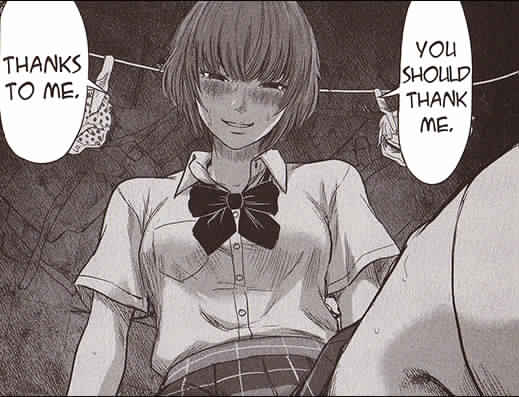Spirals swirl across the page. Your eye follows their neverending lines around and around. Page after page is covered with gruesome illustrations of bodies twisted and broken into endless versions of the shape. This is the world of famed horror manga artist, or mangaka, Junji Ito in Uzumaki, a tale of cursed spirals that infect a small Japanese seaside town and turn human beings into monsters. The iconic work of horror has been kept from anime adaptation for more than 20 years, until now. Ito announced at the 2019 Crunchyroll Expo that his manga is going to be adapted into a four-part miniseries for Adult Swim.
Ito has been writing horror manga since the late 1990s, drawing horrifying black-and-white images that defy explanation and push the human body past its limits. While he has written a few long-form manga, such Tomie, Gyo, and Uzumaki, much of his output consists of shorter stories, such as Glyceride, which makes acne even scarier, and Slug Girl, about exactly what it sounds like. His work has disgusted and amazed readers for decades, but perhaps his most well-known work is Uzumaki.

Uzumaki takes place in the fictional town of Kurōzu-cho (which translates to Black Spiral Town) where strange supernatural events begin to occur. Spirals appear everywhere, first in nature, then in and on the human body. A curse has befallen this town, showering Kurōzu-cho with a slew of Lovecraftian horrors, such as boys turning into snails and girls’ hair coming to life. Kirie Goshima, a resident of Kurōzu-cho and her boyfriend, Shuichi Saito, must work together to figure out how to save their town from destruction while also trying to stave off the spiral’s curse.
Ito’s story of cosmic horror quickly gained popularity. It was translated into English by Viz Media in 2001, then reissued as a hardback collection in 2016. It was nominated for “Best US Edition of Foreign Material” in 2003 and has been included on various essential horror graphic novel lists. The 752-page collection was then adapted into a 90-minute live-action film in 2000, which gained a cult-like status. However, not all of his works have been so successfully translated to screen.
His other popular work, Tomie, a story of a succubus, has been adapted into both live-action and anime films to varying reactions from fans. Most recently, Crunchyroll took a collection of his short works and adapted it into an anthology series, which was met with a lukewarm reception. Many fans thought that to take Ito’s black-and-white work and add color removed the beautiful simplicity of his horrors. Ito said of working with live-action and adaptation, “Comics utilize images, angles, and feelings that are hard to create in the real world. I think it’s hard to reproduce the overall atmosphere of a comic into a movie because a film must use real actors and actresses that are not perfectly matched with my original work.”
Due to this complicated history with adaptations, Ito had reportedly refused any further attempts to adapt Uzumaki. However, when he learned that Hiroshi Nagahama was a potential director of the Uzumaki anime, he changed his mind. Nagahama directed the animated versions of Mushi-shi and The Flowers of Evil, each known for their tragic beauty.

Mushi-shi is the story of Gingko, a man destined to protect humanity from nature spirits known as mushi. Each episode shows Gingko helping cure someone in need, whether it is a little boy who has miraculously grown horns or a child losing his hearing due to a mushi embedding itself in his ear. Though the basic premise revolves around a more mystical world, it is set against struggles with survival, family, love, and loss, themes that are also prevalent in Ito’s work.
The Flowers of Evil, while not mystical, portrays the horrors that children are capable of, especially when it comes to obsession. The story follows middle school student Takao Kasuga, who is forced into a “contract” by fellow student Sawa Nakamure after she catches him stealing the gym clothes of his crush. This contract leads a series of destructive events that revolve around the strange love triangle.
One critic said of Nagahama’s adaptation, “[The Flowers of Evil] stakes out a no man’s land between the living and animated worlds that is both wonderfully, alarmingly realistic and yet still spookily unreal. It’s a style that fits into no easy, prefab anime mold.” Part of its unique style comes from the fact that The Flowers of Evil was the first anime to exclusively use rotoscoping, a technique where live footage is traced over to create animation.

Nagahama has handled each story masterfully, making sure to preserve their core themes when translating the stories onto the screen. He utilizes skillful animation styles and techniques, which make his works feel unique and new. Nagahama is able to strike a fine balance between horror and beauty, creating engaging stories that enchant and horrify.
Importantly, Uzumaki will be animated entirely in black and white, maintaining Ito’s simplistic yet powerful style and avoiding issues fans have had with previous anime adaptations of his work. Colin Stetson, who wrote the score of Ari Aster’s Hereditary, will write all of Uzumaki’s music. Stetson is known for his haunting scores that utilize unique breathing techniques while he plays the saxophone.
Despite Ito’s turbulent past with adaptations of his work, Adult Swim has also put together a powerhouse of a team to finally animate Ito’s spiral-obsessed stories. Ito’s body horror has terrified international audiences and even inspired a Hot Topic clothing line. With the creation of an Uzumaki anime, Ito’s influence will hopefully continue to spread, infecting minds with a spiral-like curse.
The post Why ‘Uzumaki’ is Finally Becoming an Anime appeared first on Film School Rejects.

0 comments:
Post a Comment